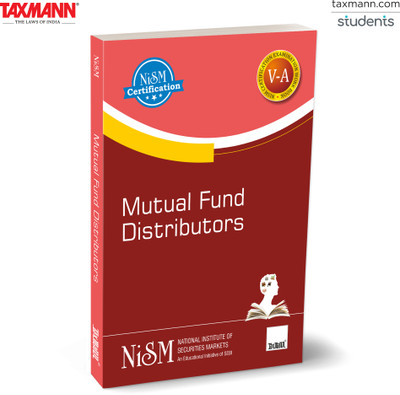NISM X Taxmann's Mutual Fund Distributors ŌĆō Understanding Mutual Fund Fundamentals | Regulations | Best Distribution PracticesŌĆöAligned with SEBI's Benchmarks & Enhanced by Industry-Backed Insights(Paperback, NISM (An Educational Initiative of SEBI))
Quick Overview
Product Price Comparison
The Mutual Fund Distributor workbook offers a structured and comprehensive understanding of mutual fund concepts, regulatory frameworks, and best practices for distribution. It is tailored to empower the readers with the critical knowledge needed to navigate the mutual fund landscape effectively, blending foundational investment principles with current regulatory guidelines in India. This book is intended for the following audience: (i) Aspiring Mutual Fund Distributors ŌĆō Individuals seeking to become mutual fund distributors or those who want to clear the NISM Mutual Fund Distributors Certification Examination (ii) Employees of AMCs and Distribution Houses ŌĆō Professionals working in asset management companies (AMCs) and entities involved in mutual fund sales and distribution (iii) Financial Advisors and Planners ŌĆō Advisors who wish to expand their knowledge base, improve client service, and stay updated on regulatory aspects of mutual fund distribution (iv) Students and Researchers ŌĆō Anyone aiming to build a career in financial services or seeking structured knowledge of the Indian mutual fund domain The Present Publication is the May 2025 Workbook Version, developed in collaboration with the Certification Team of NISM and Mr Sundar Sankaran, Ms Sunita Abraham, Mr Amit Trivedi, and Mr Joydeep Sen. It is published exclusively by Taxmann, with the following noteworthy features: (i) [Aligned to NISM Certification Requirements] Developed to meet the learning objectives and knowledge benchmarks mandated by the Securities and Exchange Board of India (SEBI) for mutual fund distributors (ii) [Comprehensive Coverage] Covers all essential aspects: from the basics of mutual funds, distribution channels, risk and performance metrics to the legal and regulatory frameworks (iii) [Lucid and Focused Content] Presents concepts in an easy-to-understand language, supplemented by relevant examples, case studies, and illustrations (iv) [Industry-endorsed and Reviewed] Developed by NISM in consultation with industry experts and resource persons, ensuring up-to-date and reliable information (v) [Practical Insights] Includes explanations of investor services, distribution practices, taxation, and KYC requirements, making it a practical guide for everyday use The coverage of the book is as follows: (i) (Investment Landscape (a) Explores the concept of savings vs. investments, major asset classes, investment risks, risk management strategies, behavioural biases in investment, and the importance of professional help vs. DIY investing (ii) Concept and Role of a Mutual Fund (a) Provides foundational knowledge of mutual funds: how they are structured, types of schemes, and the role of mutual funds within the broader financial market (iii) Legal Structure of Mutual Funds in India (a) Discusses the distinct entities that constitute a mutual fund (sponsor, trustee, AMC, etc.) and outlines their respective roles and responsibilities (iv) Legal and Regulatory Framework (a) Details SEBI's role, regulations affecting mutual funds, and the due diligence process for distributors, as well as guidelines and grievance redress mechanisms (v) Scheme Related Information (a) Explains mandatory and non-mandatory disclosures, fund factsheets, and helps readers understand how to interpret scheme-related documents (vi) Fund Distribution and Channel Management Practices (a) Covers different types of distributors, modes of distribution, commission structures, and best practices in channel management (vii) Net Asset Value, Total Expense Ratio and Pricing of Units (a) Guides on fair valuation, NAV computation, pricing of units, and the impact of entry/exit loads on NAV (viii) Taxation (a) Simplifies the income-tax implications for investors, including capital gains, dividends (IDCW option), Securities Transaction Tax, and Section 80C benefits (ix) Investor Services (a) Explains operational aspects: NFO processes, KYC requirements, systematic transactions (SIP, SWP, STP), cut-off timing, and handling non-financial transactions (x) Risk, Return, and Performance of Funds (a) Introduces different risk measures, factors affecting fund performance, and how to interpret fund returns (xi) Mutual Fund Scheme Performance (a) Focuses on performance benchmarks, price vs. total return indices, tracking error, and how fund managers' performance is measured (xii) Mutual Fund Scheme Selection (a) Guides on matching schemes to investor needs, analysing risk levels, and comparing schemes across fund houses based on strategy and performance The structure of the book is as follows: (i) Introductory Chapters ŌĆō Provide the basics and the broader context, including how mutual fund distribution fits into the financial sector (ii) Core Chapters ŌĆō Delve deeper into advanced topics like regulatory frameworks, fund accounting, valuation, sales practices, and compliance requirements (iii) Practical & Operational Chapters ŌĆō Give step-by-step guidelines to execute everyday tasks such as KYC, filling out application forms, and systematic investment plans (iv) Appendices & Resources ŌĆō Include relevant codes of conduct (AMFI Code of Ethics, AMFI Code of Conduct for Intermediaries), additional reading resources, and reference materials for deeper study

